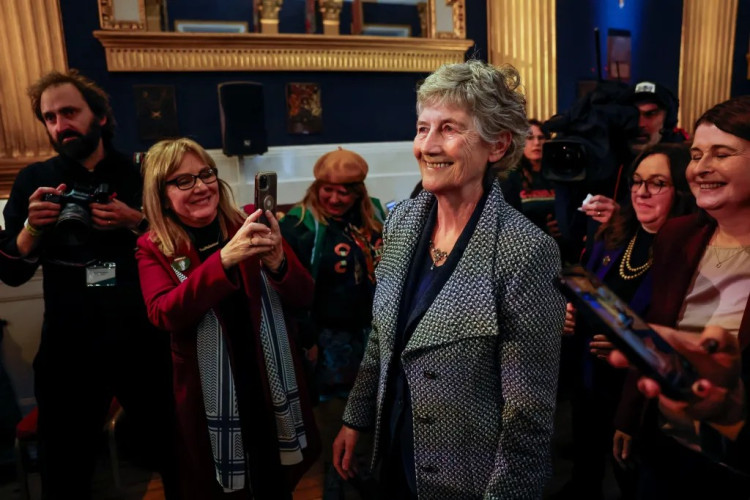Ireland elected a new President at the weekend. Independent candidate Catherine Connolly, who was backed by a coalition of left-wing parties and other independent politicians, secured a decisive victory with a first preference showing of 63.4%, the highest vote ever received by any candidate seeking the role.
The President of Ireland is the official head of state, but the role is largely a ceremonial one. Duties include signing legislation into law, formally approving the appointment of government officials, acting as Supreme Commander of the Defence Forces, and having the power to refer bills to the Supreme Court for a constitutional check, though most functions are performed on the advice of the government. However, day to day political activity is rarely impacted by actions or comments by the President.
The impact of the Connolly victory on parliamentary politics will be felt in the immediate, medium and long-term. The success of the united left approach in this campaign, involving nearly all the current opposition, may determine the strategic direction that the opposition will take for the next local, European and general elections. But, all of these elections are not due to take place until 2029. There will be a by-election in Galway West, however, to fill the seat vacated by Catherine Connolly following her election as President. The writ for this by-election must be moved by Government within six months, and the contest could be a strong indicator regarding what strategies the left will employ in future constituency scenarios. In particular, candidate selection, transfer arrangements (given Ireland PR-STV voting system) and related social media trends will be interesting to observe.
The showing of the Fine Gael candidate Heather Humphreys (centre-right), who secured 29.5% of first preference votes in Friday’s election, could cause some degree of internal disharmony within the smaller of the two government coalition parties, but it is not expected to lead to anything more serious than just that. In fact, it was Fine Gael’s best showing in a presidential election since 1973, albeit in what was effectively just a two-horse race. Of more concern to Fine Gael representatives over the time ahead will be the party’s performance in opinion polls, following some recent poor showings. With Fine Gael due to assume the office of Taoiseach in late 2027 as part of the coalition government agreement, a prolonged period of depressed poll ratings might tempt potential successors to the leadership to make a move at some stage between now and then. Right now, this does not appear to be on the cards.
For Fianna Fáil, the larger government coalition partner, the fallout may be more immediate and consequential. Their candidate, Jim Gavin, withdrew from the race on October 5th, but still appeared on the ballot paper as per electoral rules. He secured 7.2% of the first preference vote. The affair has certainly damaged the leadership of Taoiseach Micheál Martin, who heavily backed the selection of Gavin as the Fianna Fáil candidate. Reports of disquiet and demands for a change at the top of Fianna Fáil circulated widely on Sunday, with senior backbenchers John Lahart and John McGuinness leading the charge. Whether there will be a formal move from within the parliamentary party to challenge Micheal Martin’s leadership was still unclear by lunchtime on Monday. At the very least, it appears that Mr. Martin’s tenure as Taoiseach may have been shortened, with some political sources speculating that he may step aside prematurely in January 2027, following the conclusion of Ireland’s Presidency of the Council of the European Union. This would allow the incoming leader of Fianna Fáil to assume the office of Taoiseach until the handover to Fine Gael later that year. For now, even if a heave does not begin, Martin will need to work hard to rebuild trust and confidence within the ranks, with particular emphasis on inclusion and consultation.
An interesting caveat in all of this is that the turnout in the presidential election was just 45.8%, the second lowest in the history of presidential elections in Ireland, the lowest being 43.9% in 2018. Therefore, it may be an overstatement to suggest that Ireland has shifted radically to the left, despite this election ultimately evolving into a straight shoot-out between left and right for the first time in modern Irish politics. The lack of a united campaign of the right, given the unprecedented circumstances surrounding the Fianna Fáil candidate, was also a considerable factor.
Of particular note from this election was the high number of spoiled votes. 213,738 of the total poll of 1,656,436 were spoiled votes, a whopping 12.9%. Previous presidential elections typically recorded a spoiled vote count of about 1%. In the days leading up to polling, a high-profile protest campaign to spoil the vote certainly seems to have resonated with some voters. It remains to be seen whether this remarkable showing of spoiled votes will lead to government-backed proposals for constitutional reform of the nomination process for future presidential elections. Expect more on this, with opposition private member’s bills likely forthcoming on the topic in the near future.
International reporting of the result of the election has largely focused on Catherine Connolly’s left-wing background, with some references to controversial statements previously made in the context of foreign policy and international events. Much focus has centred on her recent comments regarding Hamas, when she described that organisation as forming part of the social fabric of Palestine. She also made comments recently in relation to German defence spending, likening the situation to German militarisation in the 1930s. As President, many observers expect a more nuanced tone on future pronouncements, particularly on matters of foreign policy, with Connolly effectively confirming this in one debate when indicating her willingness to meet President Trump. Keeping her broad support-base on side during her seven-year tenure may be her greatest challenge in this context, but having stated that she intends to serve for just one term, alienating the fringes may not be too dear a price to pay for high office.
The inauguration of the new President will take place in Dublin Castle on November 11th.
Brendan Griffin is a former Fine Gael TD for Kerry, Deputy Government Chief Whip and Minister for Tourism and Sport.






